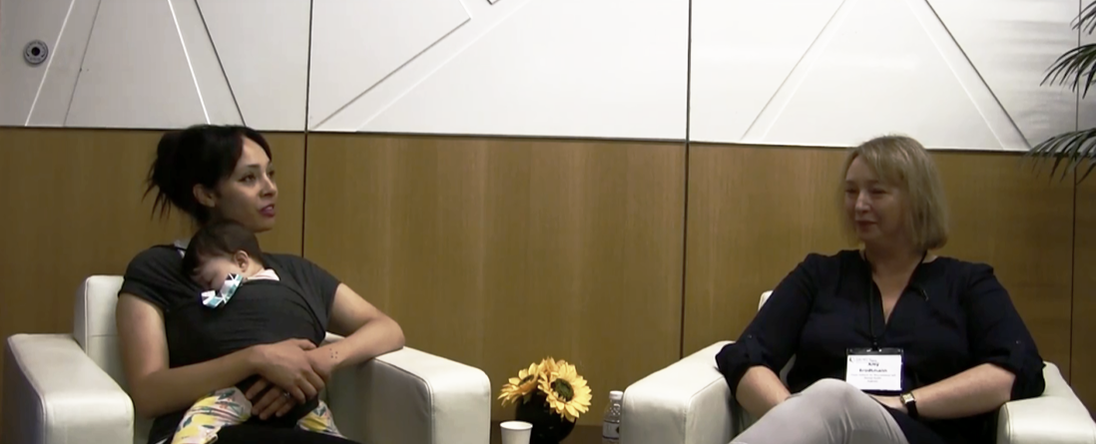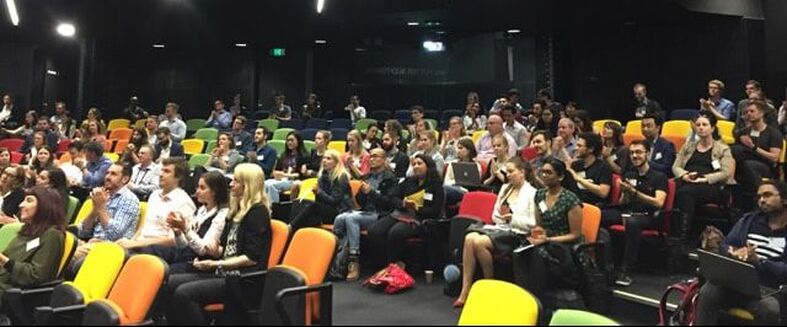OHBM Australian Chapter: Interview with Amy Brodtmann & Inaugural AUSTRALIAN CHAPTER meeting2/25/2019 By Michele Veldsman & Gabby Jean Australia has been steadily increasing its output in the field of neuroimaging. It hosts a number of leading imaging centres, including the Melbourne Brain Centre, the Brain & Mind Centre in Sydney and the Herston Imaging Facility in Brisbane. Professor Amy Brodtmann, Stroke Neurologist in Melbourne University and Inaugural Chair of the OHBM Australian Chapter, has been witness to and helped drive these developments. As a clinician-scientist she has made significant scientific contributions to our understanding of stroke, such as documenting grey matter changes and amyloid depositions in the months and years following an incident. To celebrate the first meeting of the OHBM Australian chapter we managed to interview Amy, and provide an overview of the events at this meeting. First, Michele Veldsman demonstrated her multitasking skills by interviewing Amy with her infant daughter attached (and thankfully mainly sleeping) in a baby sling. Michele Veldsman (MV): Can you tell us how you became a neuroimager? Amy Brodtmann (AB): I started carrying out Neuroimaging research back in 2000-01. I did my training as a neurologist at the Austin Health medical school in Melbourne. I wanted to learn how to understand cognitive disorders and brain plasticity and to build those skills. I was very fortunate to know Aina Puce, who many of you will know as one of the founding members of OHBM, She recommended I did an fMRI PhD, and since I’ve returned to Melbourne I’ve used imaging in almost all my projects. Sometimes it makes me wonder why I try and combine this with stroke populations as there’s a lot of pain that comes with that [laughs]. MV: And so what are the advantages of being both a researcher and a clinician? AB: The huge advantage is that I see patients every day, and questions arise every day from the people that I see. I work with both caregivers and patients. In my world that makes research easier. I’m lucky and get inspiration all the time. Then I have to think about what I’m going to do next. The disadvantages are that you’re split: I have two days a week that I’m full time clinical and the rest of the week in theory I’m part-time because of my children’s needs and running my family. I’m running around the wards as well as looking after three kids. MV: As a stroke neurologist your work has clear links to brain plasticity. What do you think are the big findings in that area and do you think there will be a lot of translation into the clinic? AB: I looked initially at a series of stroke patients who were in their mid-80s and saw enormous changes in their brains. Our brains are quite phenomenal. We saw changes in an area of the brain that, according to the textbooks, was supposed to be very static and isn’t supposed to exhibit much experience-dependent plasticity. That was in primary visual cortex: striate. What was so interesting is that these heteromodal cortices are always the areas that kick in – we were seeing activations in the same hemisphere, ipsilesionally and then contralesionally, and after the plasticity we wondered if the brain then goes on to degenerate. I think that most of that degeneration is due to stroke being just another example of a risk factor. Thinking about the effects of physical activity, we found that the percent of the day spent active was associated with better retention of function. MV: You were also interested in the link between stroke and dementia. What do you think neuroimaging is going to tell us about that? AB: We’ve got a number of different factors at work. Patients who have had a stroke have already got the risk factors that can affect their brain prior to the stroke. Then we’ve got changes due to the stroke itself. Then we’ve got potential deafferentation or disconnection from both the stroke and white matter hyperintensities. So I think that it’s really different – we need to understand which areas are affected first, old fashioned structural imaging. The second thing we have to understand is how does that affect networks, thinking of Bill Seeley’s work and how others have explained how networks are affected. It’s really critical because I don’t think it’s going to be quite so straightforward in stroke. I think that there are so many areas that are potentially affected, so we’ll need to very carefully unpack what’s happening in the frontal lobes. I think we’ll have to think about how we factor in both structural and functional connectivity and how they can interact. There are so many ways that imaging is going to help us understand this process – we can not only chart observationally but we can start to look at the grey matter in terms of cortical thickness and the thalami and hippocampi and understand regional vulnerability. Critically we can also understand the processes going on in the white matter, and finally we’ve got methods that allow us to do that, which is really exciting. [Michele’s child wakes up contentedly – and allows the interview to continue] MV: So the Australian OHBM Chapter has recently started, what are the aims of the chapter and where do you see it going in the next five years? AB: This was something that Michael Breakspear suggested to us last year. He’s on council for OHBM. Michael suggested to a number of us that come to the meetings regularly that we should make an application for a chapter. So we got a group together and made a pitch and OHBM were keen to get local chapters up and running. I know that within Melbourne and outside Melbourne there are plenty of projects that share interests or methods. We’re uniquely situated to do that in Australia given our population. The big focus will be on getting more people connected and people interested and getting our PhDs and postdocs to get together. OHBM has always had that youthful drive and focus and I want that to stay the same. We start to get a bit more concrete as we get older – it must be that vascular brain burden and it’s really good to have people say ‘why not?’. I love a ‘why not?’. MV: Thank you!  Gabby Jean then provided us with an update on events at the OHBM Australia Chapter meeting: On 12 October 2018, the first inaugural meeting of the OHBM Australian Chapter was held at the Melbourne Brain Centre. Our aim was to introduce the neuroimaging community in Australia, to maintain current and form new networks of regional and international collaborations across all disciplines of neuroscience and neuroimaging. Our first meeting had a great turn out, with nearly 200 registered attendees. The day was kicked off by a brief overview of the OHBM Australian Chapter and its mission, followed by an inaugural keynote by Professor Michael Breakspear, past OHBM treasurer. A second keynote presentation by Professor Caroline (Lindy) Rae detailed what we are exactly mapping in ‘human brain mapping’. We heard about impressive and inspirational work presented by PhD students in a ‘PhD data blitz presentations’ session and by junior postdocs in the ‘post-doc presentations’ session. Sila Genc won the prize for best PhD blitz presentation and Steffen Bollmann won the prize for best post-doc presentation, although all PhD and postdoc presentations were of exceptionally high quality. In addition to hearing about great neuroimaging work carried out throughout Australia, delegates broke into smaller workgroups to discuss ideas for a potential large collaborative research effort similar in scope to the UK Biobank initiative. This brainstorm session was introduced by Dr. Lianne Schmaal who presented an overview of current international and national ‘big data’ initiatives. Amy Brodtmann then presented an overview of potential funding opportunities for such a big data initiative in Australia. After lunch, each workgroup presented their proposal for a big data initiative in Australia, which included many interesting and partly converging, partly unique ideas. We aim to further follow-up with the OHBM Australian Chapter community on these great ideas for a large-scale data collection initiative in Australia (for further details check us out on our chapter site). Overall, we believe the inaugural meeting was a success and we hope it was productive and interesting for all attending. We would like to thank everyone for their attendance and great contributions to the discussions. Please stay tuned for upcoming events in 2019!
0 Comments
Your comment will be posted after it is approved.
Leave a Reply. |
BLOG HOME
Archives
January 2024
|


 RSS Feed
RSS Feed